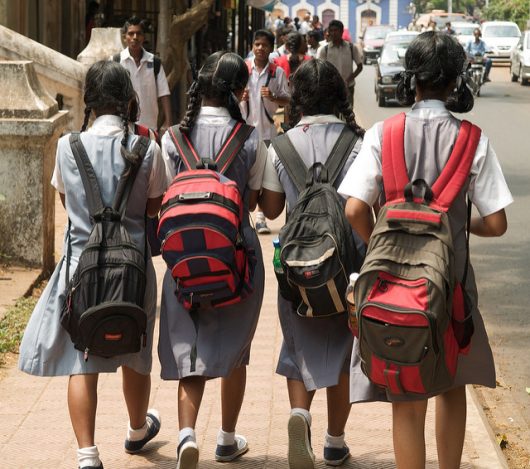Girls’ Education in India Still Requires Significant Improvement

Education is a necessary component for the growth of a nation and educating girls still continues to be a problem in most developing countries. India has made quite considerable progress with an overall increase in literacy rates from 64.8 percent in 2001 to 74.04 percent in 2011, but girls’ education in India still requires improvement in a number of ways.
The Current Situation in India
The literacy rate of women, according to 2011 census, is 64.46 percent while the male literacy rate is 82.14 percent. The top states that have the largest number of literate women in India are Kerala (92 percent), Mizoram (89.4 percent), Lakshadweep (88.2 percent), Tripura (83.1 percent) and Goa (82 percent). At the same time, Andhra Pradesh, Karnataka, Kerala, Tamil Nadu and West Bengal have the largest number of women entrepreneurs in the nation.
The states that include the lowest female literacy numbers are Rajasthan (52.66 percent), followed by Bihar (53.33 percent), Jharkhand (56.21 percent) and Jammu and Kashmir (58.01 percent). Though there has been a substantial increase in the number of literate women in the past few years, the number still falls low for the entire nation.
How This Situation Arose
One of the main reasons for the lack of girls’ education in India is the male-dominated society. Even though the country is making progress, the belief that women belong in the home is still widely held.
Gender inequality is a very serious issue in the Asian nation, which is why 10 million female babies have been aborted over the past 20 years. A son’s education is given more importance because it is thought that daughters will eventually get married and live with their husband, so many believe that a girl’s education is not of much help directly to her family.
Addressing Girls’ Education in India
The government has taken numerous strategies to improve girls’ education in India:
- Beti bachao, beti padhao (Save daughters, educate daughters) was conceived in 2015, which addresses the issue of the declining Child Sex Ratio (number of females per thousand males aged zero to six) across the country. It is a joint initiative by the Ministry of Women and Child Development, the Ministry of Health and Family Welfare and the Ministry of Human Resources. This strategy works to stop female foeticide, increase the number of girls attending schools, decrease school dropouts, implement rules regarding the right to education and increase the construction of toilets for girls.
- Progress has been made in the northwestern part of India, especially in Rajasthan. New literacy efforts have been made to boost the number of girls attending school and a summer coding camp aims to introduce computers to girls.Michael Daube, an American artist and founder of a New York-based nonprofit, is raising money for an all girls’ school. Furthermore, Manhattan Architect Diana Kellogg is building an exhibition hall where female artists can display and sell their products, thus increasing employment.
- Jharkhand has taken a big initiative toward female education upliftment. The Jharkhand School of Education has decided on distributing free textbooks, uniforms and notebooks to all girl students from grades nine through 12.
- Gurgaon, located in the Indian state of Haryana, aims to provide free education to girls in grades nine through 12.
- The Uttar Pradesh government plans to provide a monetary incentive of 30,000 rupees to female students who have an outstanding performance in intermediate or equivalent state examinations.
- UNICEF is also working with the Indian government to provide quality education for all girls. As a result, Bihar has now made girls’ education a priority. A new program has been initiated in Bihar which includes education for daughters and thousands of girls are now attending school.
The situation in India may seem daunting but it is steadily progressing with time. With hope, in the coming years, girls’ education in India will achieve new heights.
– Shweta Roy
Photo: Flickr
